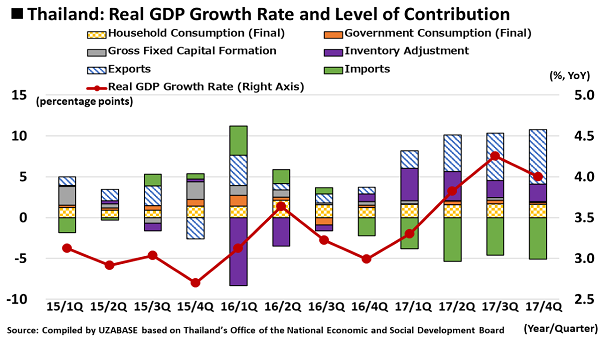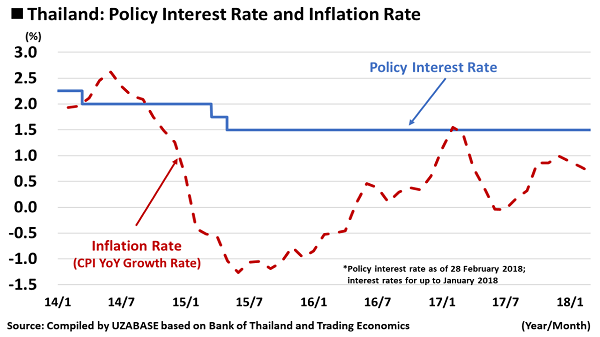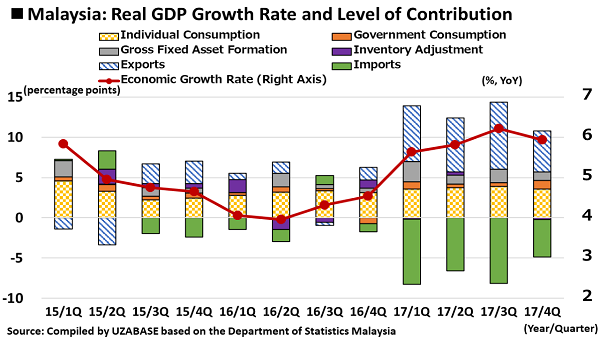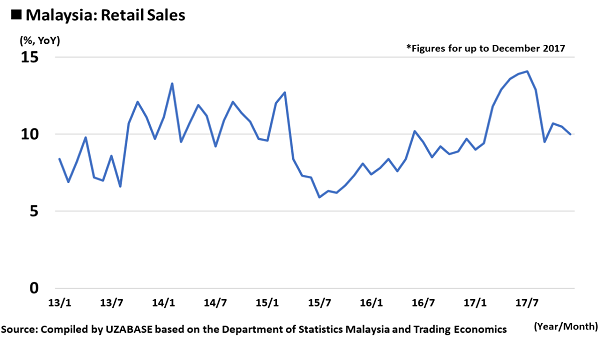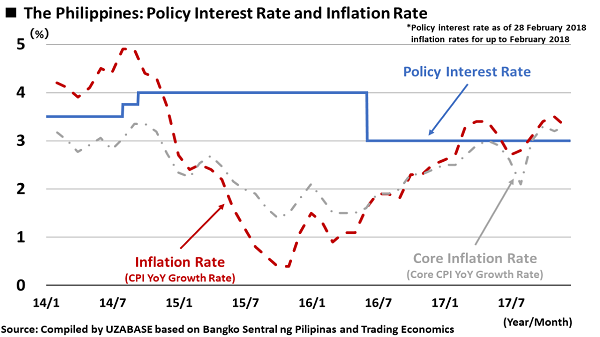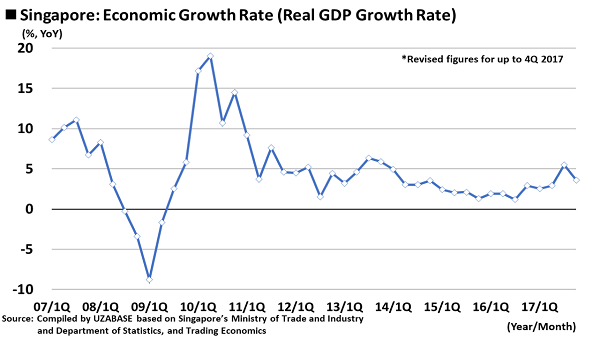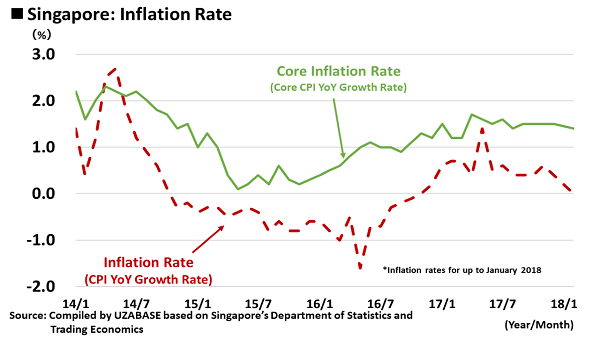Malaysia Continues to Exhibit High Growth; Low Inflation Rates in Thailand and Singapore Call for Attention
|
Key Focus for February |
|
In February, Indonesia, Thailand, and Malaysia released their 4Q 2017 GDP statistics, while Singapore announced revised figures for the same period. While Malaysia’s growth decelerated slightly, the country still continued to maintain a fast pace close to 6% YoY. |
|
Indonesia continued on a gradual recovery path, and Thailand experienced a slight deceleration in growth, but still maintained a strong level. The inflation rate for the Philippines continued to accelerate, whereas attention is required for the inflation rates in Thailand and Singapore, which are at low levels near 0%. |
|
Indonesia: Economic Conditions Continue on Gradual Recovery Trend |
|
Indonesia’s 4Q 2017 GDP statistics were announced on 5 February, with the country’s economic growth rate (real GDP growth rate) recorded at 5.2% YoY. This rate is nearly flat from the 5.1% YoY recorded for 3Q 2017, though it rose slightly above, and while the pace has been light since the 4.9% YoY for 4Q 2016, it continues to accelerate. Going forward, amidst a backdrop of relaxation policies for the financial sector and rising crude petroleum prices, this rate is likely to continue accelerating gradually. The rate for 2017 overall was recorded at 5.1% YoY, which is also nearly flat in comparison to that of 2016, which was 5.0% YoY. |
|
|
|
Indonesia’s Business Confidence Index (BCI) for 4Q 2017 was 111.0. Although this marked a decline from the 112.4 for 3Q that year, Indonesia’s BCI continues to exceed 100, which is considered “optimistic”. In terms of individual consumption, the country’s Consumer Confidence Index (CCI) for January 2018 was 126.1, which is nearly flat from the 126.4 recorded for December 2017. Indonesia’s CCI also continues to exceed 100, which is considered “optimistic” similarly to the BCI, by a great extent. |
|
Indonesia’s retail sales for December 2017 were up by 0.7% YoY, though this marked a deceleration from the 2.5% recorded for the previous month. There are some in the retail industry claiming that business conditions will be severe for the time being, and data continues to support these claims. The fact that retail is not experiencing an increase despite a strong CCI suggests that household consumption has been focused on the service industry, such as tourism and restaurants. |
|
|
|
For January 2018, Indonesia’s headline inflation rate was 3.3% YoY (December 2017: 3.6% YoY), while its core inflation rate was 2.7% YoY (December 2017: 3.0% YoY), revealing that the country’s inflation has slowed down. |
|
|
|
Thailand: Economic Conditions Are Steady, but Recovery in Internal Demand Is Lagging Behind |
|
Thailand announced its economic growth rate (real GDP growth rate) for 4Q 2017 at 4.0% YoY, which marked a deceleration from the 4.3% YoY announced for 3Q. That said, 3Q and 4Q 2017 recorded two consecutive quarters of growth above 4%, which was the first time since the 4Q 2012 to 1Q 2013 period, and growth is likely to be steady over the medium-to-long term. Furthermore, the growth rate for 2017 overall was 3.9% YoY, which was an acceleration from the 3.3% for 2016. |
|
|
|
On 14 February, the Bank of Thailand (BOT) held its regular Monetary Policy Committee Meeting, where it decided to keep the current policy interest rate of 1.50%. In a statement released after the meeting, the BOT maintained its understanding that the domestic economy is continuing to recover as it has done up to this point, driven by the export of assets and services. Household consumption has been gradually improving, with an increase seen in the purchase of durable goods, and it has been pointed out that household consumption has started contributing to the country’s economic recovery. |
|
However, the BOT also displayed the understanding that the improvement in household consumption has stopped at a sluggish level because of structural issues in the employment market and an increase in household debt. It can be inferred that the issues in the employment market structure are the fact that approximately 30% of Thailand’s workforce is employed in the agricultural sector, which has a low income level, as well as the progression of the country’s ageing society. Household debt in Thailand amounts to a share of 79.0% of the country’s GDP, which is a high level amongst Southeast Asian countries, following behind Malaysia (88.3%). This share is also ranked 13th worldwide. As these two issues may be difficult to fix in the short term, Thailand’s economy will continue to be influenced by external demand. |
|
For January 2018, Thailand’s headline inflation rate was 0.7% YoY (December 2017: 0.6% YoY) and its core inflation rate was 0.6% YoY (December 2017: 0.6% YoY), with both remaining nearly flat. The country’s economic conditions are gradually improving, and even when taking into consideration that Thailand is a major agricultural nation with a high level of self-sufficiency for foodstuffs, it still has a low inflation rate. This suggests that it will still take time for the country’s economic recovery to strengthen. |
|
|
|
Exports were up by 17.6% YoY in January 2018, remaining at a favourable level. As imports are on the rise amidst a backdrop of economic recovery, Thailand’s balance of trade was recorded at USD -0.12 billion, marking the second consecutive term of deficits. However, the country’s current account balance was USD 5.21 billion, and has continued to be positive owing to revenue from tourism, thus limiting concerns over the depreciation of the baht. |
|
Malaysia: High Growth Rate Continues, Recorded at 5.9% for 4Q |
|
On 14 February, the Department of Statistics Malaysia announced the country’s economic growth rate for 4Q 2017 at 5.9% YoY. This rate was a little sluggish compared to the 6.2% for 3Q that year, but when taking into consideration that Malaysia’s per capita GDP is USD 9,690 (2017 estimate by the International Monetary Fund), which is high amongst middle-income countries, it can be said the country is continuing to exhibit high growth. |
|
|
|
In January 2018, the Central Bank of Malaysia (Bank Negara Malaysia; BNM) raised its interest rate to avoid an overheated economy, which can be considered as a suitable measure. The country’s inflation rate for that month was 2.7% YoY, which is a slower rate than the 3.5% YoY for December 2017. There appear to be no special issues when considering the country’s economic growth rate and high interest rate level. |
|
Malaysia’s Coincident Index and Leading Index for December 2017 both turned negative from previous figures, being recorded at -0.2% YoY (November 2017: 0.5% YoY) and -1.8% YoY (November 2017: 0.5% YoY), respectively. As these figures have generally been on positive trends, future trends in data call for attention to see whether this negative trend is temporary. |
|
The country’s retail sales for December 2017 were up by 10.0% YoY, continuing to exhibit a high level of growth. In addition, the country’s production value in the construction sector for 4Q 2017 was up by 7.7% YoY, and while this is a slowdown from the 8.1% YoY for 3Q, it remains at a favourable level, reflecting the high GDP growth around 6%. Going forward, consideration may be required for whether there will be a risk of oversupply. |
|
|
|
The Philippines: Policy Interest Rate Remains the Same, but Inflation Rate Calls for Attention |
|
On 8 February, the Central Bank of the Philippines (Bangko Sentral ng Pilipinas, BSP) held its regular Monetary Policy Meeting, where it decided to keep the 3.00% policy interest rate as is. In a statement issued after the meeting, the BSP noted that while the country’s inflation rate has been accelerating as of late, it is estimated to settle within the 3%±1% range for the year, and given the continuous strong growth in the country’s economy supported by strong internal demand and a recovery in the global economy, the BSP believes that maintaining the current policy interest rate is best. |
|
The BSP also pointed out that the acceleration of the inflation rate due to a rise in crude petroleum prices is a risk factor going forward. Primarily, the BSP appears to have the understanding that the inflation rate will settle at the target range, but also holds a growing sense of caution. |
|
The country’s headline inflation rate for January 2018 was 4.0% YoY (December 2017: 3.3% YoY) and its core inflation rate was 3.9% YoY (December 2017: 3.0%), exhibiting a continuous trend of acceleration. |
|
|
|
Singapore: Inflation Trends Call for Attention |
|
On 14 February, the revised value for Singapore’s 4Q 2017 economic growth rate was announced at 3.6% YoY, which is an upward revision from the preliminary figure of 3.1% YoY that was announced in January. |
|
|
|
Singapore’s non-petroleum exports exhibited high growth in January 2018 at 13.0% YoY, but this high growth was likely a reaction to low level recorded for the base period of January 2017 as per the traditional Chinese New Year (Lunar New Year). For the same reason, industrial production also exhibited high growth in January 2018 at 17.9% YoY. |
|
Singapore’s headline inflation rate was 0.0% YoY and -0.2% MoM in January 2018, while its core inflation rate was 1.4% YoY. Although the risk of deflation calls for attention, the country’s core inflation rate has been at a suitable level that likely does not require any strong caution at present. |
|
|
|
Vietnam: Clear Effects from the Vietnamese New Year |
|
Aside from the aforementioned countries, Vietnam announced macroeconomic statistics for February at the end of the month, and the data revealed clear effects from the Vietnamese New Year Tết. |
|
The number of visitor arrivals into Vietnam in February rose by 19.4% YoY, which is a substantial deceleration from the 42.0% YoY recorded for January. However, this number continues to grow at a high level. The fact that the number of foreign travellers to Vietnam was high in spite of deceleration due to effects from Tết calls for attention. |
|
The country’s industrial production in February was up by 8.0% YoY, decelerating from the 20.9% YoY in January. Its retail sales, however, accelerated to 14.8% YoY from 9.5% YoY over the same period. These trends displayed typical characteristics, namely a decrease in production and an increase in consumption, during the long vacation for Tết. |
|
Vietnam’s balance of trade for February was announced at USD 900 million, recovering to positive territory for the first time in three months. Amidst an increase in imports with Tết in the backdrop, this positive balance reveals that the country’s export sector is growing favourably in response to global demand. |







